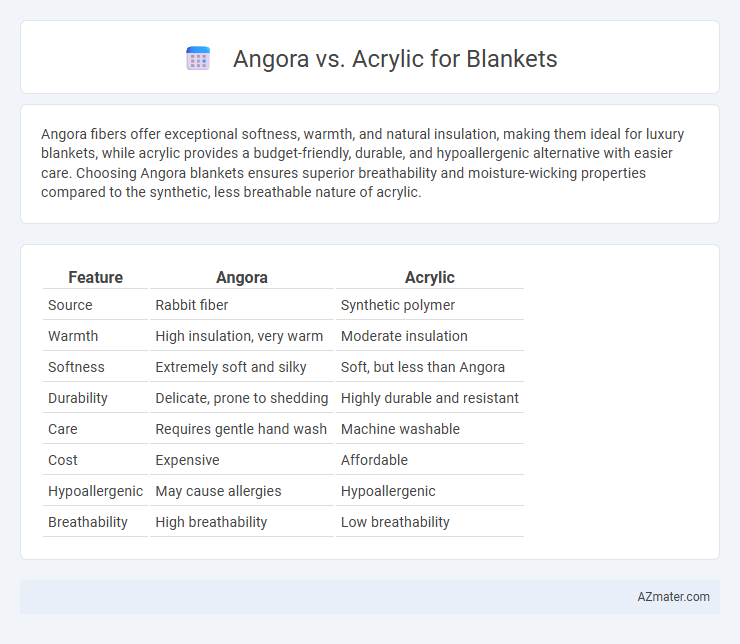Angora fibers offer exceptional softness, warmth, and natural insulation, making them ideal for luxury blankets, while acrylic provides a budget-friendly, durable, and hypoallergenic alternative with easier care. Choosing Angora blankets ensures superior breathability and moisture-wicking properties compared to the synthetic, less breathable nature of acrylic.
Table of Comparison
| Feature | Angora | Acrylic |
|---|---|---|
| Source | Rabbit fiber | Synthetic polymer |
| Warmth | High insulation, very warm | Moderate insulation |
| Softness | Extremely soft and silky | Soft, but less than Angora |
| Durability | Delicate, prone to shedding | Highly durable and resistant |
| Care | Requires gentle hand wash | Machine washable |
| Cost | Expensive | Affordable |
| Hypoallergenic | May cause allergies | Hypoallergenic |
| Breathability | High breathability | Low breathability |
Introduction to Angora and Acrylic Blankets
Angora blankets, made from the soft, luxurious fibers of Angora rabbits, offer exceptional warmth, lightweight comfort, and natural breathability, making them ideal for cozy, high-end bedding. Acrylic blankets, crafted from synthetic polymer fibers, provide affordability, durability, and easy maintenance while mimicking the softness of natural wool. Both materials serve distinct purposes in blanket manufacturing, with Angora prized for premium warmth and acrylic favored for budget-friendly versatility.
What is Angora?
Angora is a natural fiber derived from Angora rabbits, prized for its exceptional softness, warmth, and lightweight feel in blankets. This luxurious material boasts excellent thermal insulation due to its hollow fiber structure, making it far warmer than synthetic alternatives. Compared to acrylic, Angora offers superior breathability and moisture-wicking properties, ensuring a cozy and comfortable blanket experience.
What is Acrylic?
Acrylic is a synthetic fiber made from polyacrylonitrile, commonly used in blankets for its affordability, durability, and ease of care. It mimics the softness and warmth of natural fibers like wool or cashmere but offers resistance to moths, mildew, and fading. Acrylic blankets are lightweight, machine washable, and maintain color vibrancy over time, making them a practical alternative to Angora.
Softness and Texture Comparison
Angora wool offers unparalleled softness and a silky, luxurious texture due to its fine fibers, making it highly desirable for cozy blankets. Acrylic blankets provide a soft feel but lack the natural smoothness and warmth of Angora, often feeling synthetic and less breathable. The natural loft and gentle drape of Angora enhance comfort, while acrylic's durability and ease of care come at the cost of a less plush texture.
Warmth and Insulation
Angora fibers offer superior warmth and insulation for blankets due to their hollow core, which traps air effectively, providing exceptional thermal regulation. Acrylic blankets, while affordable and lightweight, lack the natural insulating properties of angora and tend to retain less heat. As a result, angora blankets deliver enhanced coziness and warmth in cold environments compared to acrylic alternatives.
Durability and Longevity
Angora blankets, made from fine, natural fibers of the Angora rabbit, offer exceptional softness but require delicate care to maintain durability, as the fibers can be prone to shedding and pilling over time. Acrylic blankets provide greater resistance to wear and tear, maintaining color and shape after multiple washes, making them a more durable choice for frequent use. When prioritizing longevity, acrylic blankets generally outperform Angora in terms of maintenance and sustained durability under regular use conditions.
Care and Maintenance
Angora blankets demand gentle care, including hand washing or using a delicate cycle with cold water, avoiding bleach and fabric softeners to maintain fiber softness and prevent damage. Acrylic blankets allow for easier maintenance, typically machine washable with warm water and can withstand light tumble drying, offering durability and resistance to wrinkles. Proper storage for both fabrics involves keeping them in a cool, dry place away from direct sunlight to prevent deterioration and color fading.
Allergen Considerations
Angora fibers, derived from Angora rabbits, are natural and hypoallergenic, making them suitable for sensitive skin but may trigger allergies in individuals with animal fiber sensitivities. Acrylic blankets, made from synthetic polymers, are generally hypoallergenic and resistant to dust mites, offering a safer alternative for allergy sufferers. Choosing between Angora and Acrylic blankets depends on individual allergen sensitivities and the environmental factors affecting indoor air quality.
Price and Affordability
Angora blankets generally come with a higher price tag due to the labor-intensive harvesting process and the rarity of Angora fibers, making them a luxury investment. Acrylic blankets offer a significantly more affordable option, as synthetic fibers are cheaper to produce and widely available, catering to budget-conscious consumers. The cost difference between Angora and acrylic blankets reflects not only material value but also the durability and softness each fiber provides.
Which is Best for Your Blanket?
Angora fibers provide exceptional softness, warmth, and natural insulation, making them ideal for luxurious and cozy blankets, while acrylic offers affordability, durability, and easy care with resistance to moisture and insects. Angora blankets tend to be more delicate and require gentle maintenance, whereas acrylic blankets are machine-washable and maintain their shape and color over time. Choosing between Angora and acrylic depends on your preference for either premium softness and warmth or practicality and budget-friendly durability in a blanket.

Infographic: Angora vs Acrylic for Blanket
 azmater.com
azmater.com